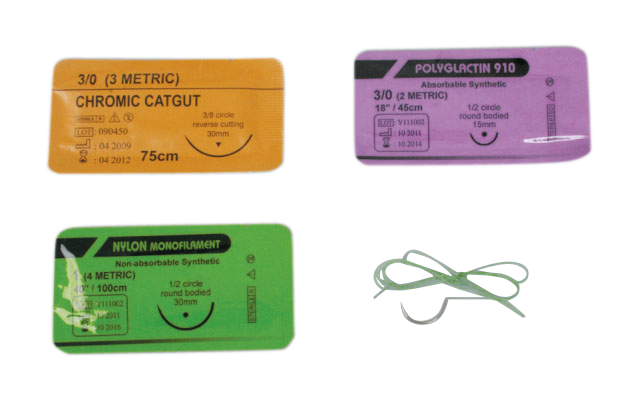
Sutures
Sutures are used to close deep wounds or cuts. When a deep wound is present, a doctor may need to sew the two edges of the wound together layer by layer. When this happens, sutures are left under the skin and removed at a later date, after the wound has healed.
Ref. No.:NMS130101 Nylon, with needle
Ref. No.:NMS130102 Silk (braided), with needle
Ref. No.:NMS130103 Plain catgut, with needle
Ref. No.:NMS130104 Chromic catgut, with needle
Ref. No.:NMS130105 Synthetic Absorbable Suture (PGA), with needle
Ref. No.:NMS130106 Polypropylene suture, with needle
Ref. No.: NMS130107 Polyester (braided) suture, with needle
Ref. No.:NMS130108 Stainless steel wire, with needle
Sutures, also called stitches, are a medical item used to close wounds or surgical incisions. They are usually made of a material that dissolves over time, such as catgut or absorbable synthetic materials, but can also be made of non-absorbable materials like nylon or stainless steel. The size and type of suture used depends on the wound being closed. Sutures are placed by a doctor or nurse and tied in a knot to hold the skin edges together. The ends of the suture may be buried under the skin (subcuticular) or left outside (extracuticular). Sutures usually stay in place for 7-10 days before being removed. Dissolvable sutures will eventually disappear on their own. Sutures are an important part of wound healing as they help to close the wound and prevent infection. They also help to minimize scarring by holding the skin edges together so that they can heal in alignment.
There are many different types of sutures, each with their own specific purpose. The most common type of suture is the absorbable suture, which is made from materials that are slowly broken down by the body. These types of sutures are often used in areas that do not need to be permanently closed, such as the intestines or uterus. Non-absorbable sutures are made from materials that will not be broken down by the body, such as nylon or stainless steel. These types of sutures are often used in areas that need to be permanently closed, such as the skin.
Sutures are a medical device that is used to close wounds or surgical incisions. They are typically made from materials such as gut, silk, or synthetic fibers, and are available in a variety of sizes and shapes. Sutures can be placed using a number of different techniques, depending on the type of wound being closed. The main purpose of sutures is to promote healing by holding the edges of the wound together and providing support during the healing process. In addition, sutures can help to minimize scarring by keeping the wound edges aligned during healing. There are many different types of sutures available, each with its own advantages and disadvantages. The type of suture that is best for a particular wound will depend on a number of factors, including the size and depth of the wound, the location of the wound, and the patient's individual preferences. Some common types of sutures include:
Absorbable sutures: These sutures are made from materials that are slowly broken down by the body's natural enzymes. Absorbable sutures are commonly used for internal wounds that do not require long-term support. They typically dissolve within 1 to 2 months.
Non-absorbable sutures: These sutures are made from materials that do not break down in the body. Non-absorbable sutures are often used for external wounds that need longer-term support. They typically remain in place for 6 to 8 weeks.
Barbed sutures: These sutures have small barbs or hooks along their length that help to keep them in place. Barbed sutures are often used for deep or difficult-to-close wounds.
There are many different benefits of using sutures, including:
Sutures can help to promote healing by holding the wound edges together and providing support during the healing process. In addition, sutures can help to minimize scarring by keeping the wound edges aligned during healing.
Sutures can be removed when the wound has healed, which allows for cosmetic surgery to improve the appearance of the scar.
Sutures are a relatively simple and low-risk medical procedure. Complications from suture placement are rare and typically minor.
If your wound is more than a quarter-inch deep, if it’s gushing blood, or if the edges of the wound don’t line up well, then you probably need stitches. You also might need them if the wound is on your face, hands, feet, genitals, or joints. If you have a big cut or laceration, medical professionals will often decide to close it with sutures. The process of sewing up a wound helps promote healing by keeping the skin edges together so that new cells can grow across the wound. This type of cell growth is called epithelialization and is crucial for healing wounds.